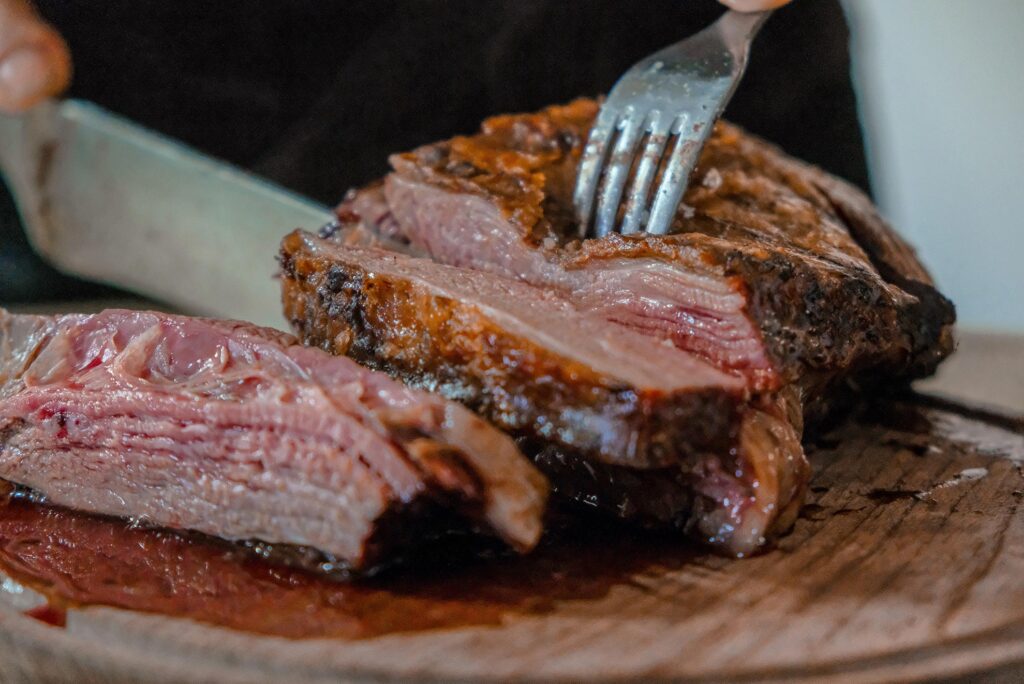
Why Beef is Aged, and How: Beef must be aged to allow natural enzymes to break down fibrous connective tissue that holds the muscle together. There are two ways to self-tenderize: · Dry aging: Expensive and time consuming. The beef is stored in temperature- and humidity-controlled coolers for up to six weeks. Moisture evaporates, improving texture and concentrating flavor. Between the evaporation and trimming of the thin coating of mold that develops, there’s weight loss of up to 20 percent. · Wet aging: The beef is refrigerated in vacuum-sealed plastic and allowed to tenderize in its own juices. No evaporation means no moisture is lost. Less waste but also less concentrated taste.
Some Types of Beef You Should Know About: Rare “red” cattle (the same breed that produces Kobe beef) raised in Texas by HeartBrand Beef–the only herd outside of Japan. They started with eleven head of cattle, which have been guarded by armed Texas Rangers for the past fourteen years while the herd has grown to more than five thousand. Grass-fed: Healthier but, some say, less flavorful than corn-fed. Raised in open pastures. Not necessarily organic. (Grain-finished cattle–which are switched from grass to grain for the last few weeks before slaughter–develop more marbling.) · Heritage: From rare heirloom breeds, pasture-raised on small farms without the hormones or pesticides used in conventional agribusiness. · Angus: Aberdeen-Angus is a pure breed found in the U. S., England, Scotland, and Ireland. Certified Angus Brand is a brand name and may or may not include meat from Aberdeen-Angus.
The Grades of Meat: Prime: What you want. Typically found only at fine butcher shops, its interlacing of intramuscular fat–like a cobweb–assures tenderness, juiciness, and flavor. · Choice: Pretty good. More affordable and accessible than prime, moderate marbling still yields juicy, flavorful cuts. · Select: You’re on a plane.
Generally Important Point (Cooking): Cooking times in recipes are predicated on starting with meat that’s not too cold. All steaks should be taken out of the refrigerator at least thirty minutes before cooking.
The Pan: Lodge, an American maker of high-quality cast-iron pans for more than a hundred years, preseasons pans in the factory (its “Logic” line). The 10.25- and 12-inch, with 2-inch depth, are most practical–any larger and, depending on the size of the steaks, the oil could run off to the sides (where there’s no meat) and burn. · The pan must be hot enough to sear the meat on contact, to prevent surface moisture from creating steam, which can prevent browning. · While some chefs say the pan should be “smoking” before adding oil, most call for the intuitive “hot but not smoking.” Basically, really goddamn hot.
A Note on Salt: When you salt meat before cooking, you need a lot–and a lot falls off–so standard coarse salt will do. After cooking is the time to use fine sea salt. It’s pricey, but the large, crackly flakes are intense, so you don’t need much.
How to Use Oil: Before the meat goes in, the skillet should be filmed with oil–it should coat the surface without pooling. (You can add it when the pan is cold or hot.) At the right temperature, the oil will shimmer and gently ripple, as if you dropped a pebble into a pond. It shouldn’t spatter or smoke.
The Finish: Meat’s temperature keeps rising after cooking. Remove steaks from the heat when a meat thermometer reads 115 to 125 degrees. Then wait. During the all-important resting period, the temperature will rise to the medium-rare range, 120 to 130 degrees. · Get a good thermometer, preferably with a digital probe and large readout, like the Super-Fast Thermapen (four seconds with 1 percent accuracy). It is a potentially life-changing device. Always start with a recipe’s minimum cooking time. You can’t cook a steak less. · If you don’t have a thermometer and you don’t want to cut into the meat, press the cartilage at the tip of your nose. That’s what medium rare feels like.



